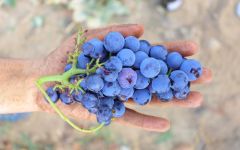Domaine de Cristia Chateauneuf-du-Pape Vieilles Vignes 2019
-
Jeb
Dunnuck -
Wine
Spectator - Decanter
-
Robert
Parker



Product Details
Your Rating
Somm Note
Winemaker Notes
Deep black robe with hints of purple, Complex nose with notes of red fruits and garrigue associated with discreet and elegant toasted oak. Delicate and textured palate with spices, and milk chocolate notes. The finish is fresh, tight and rich, full of jammy fruit
Professional Ratings
-
Jeb Dunnuck
The 2019 Châteauneuf Du Pape Vieilles Vignes (100% Grenache) brings more opulence and sexiness, with a more unevolved vibe in its ripe black fruits, violets, toasted spice, and Provençal garrigue-like aromas and flavors. Brought up in equal parts used barrels, new French oak, and demi-muids, it hits the palate with full-bodied richness, a seamless, incredibly elegant texture, ripe tannins, and one hell of a great finish. This is a Grenache lover's dream, and it should continue drinking brilliantly for another 10-15 years.
-
Wine Spectator
A strapping young wine, brimming with dark plum paste and boysenberry compote flavors that are carried by racy licorice snap and fruitcake notes. The lively back end shows a hint of bramble and a touch of tar, giving this energy and power as it courses through the finish. Best from 2023.
-
Decanter
Better balanced than the Renaissance, not so much oak with the natural power of the fruit to the fore. It's very ripe, quite muscular and towards sweet in profile. A bright, zingy, technicolour style, polished and sleek, but will have plenty of fans. Warming alcohol. 100% old-vine Grenache from the lieu-dit Cristia sandy soils. Matured in barriques and demi-muids for 18 months, one-third new oak.
-
Robert Parker's Wine Advocate
All Grenache, the 2019 Chateauneuf du Pape Vieilles Vignes matured in a mix of demi-muids and barriques, with about one-third new oak. Faint herbal notes and nuance to this wine's cedar, vanilla and black cherry flavors. It's full-bodied, concentrated and reasonably tannic, but it finishes silky and fine. Tasted twice (once blind), with consistent notes. Best after 2023. Rating: 91+
Other Vintages
2020-
Jeb
Dunnuck -
Wine
Spectator -
James
Suckling -
Robert
Parker
-
Jeb
Dunnuck - Decanter
-
Wine
Spectator
-
Jeb
Dunnuck -
Robert
Parker
-
Jeb
Dunnuck -
Wine
Enthusiast -
Wine
Spectator -
Robert
Parker -
Wine &
Spirits
-
Wine
Spectator -
Robert
Parker -
Jeb
Dunnuck -
James
Suckling
-
Robert
Parker -
Wine
Spectator
-
Robert
Parker -
Jeb
Dunnuck -
Wine
Spectator
-
Wine
Spectator -
Robert
Parker
-
Robert
Parker -
Wine
Spectator






Created by Etienne Grangeon 70 years ago, the property originally comprised 2 hectares of Grenache. It was developed further by the driving force of his son Alain, who joined the domaine in 1963. Passionate about viticulture, he notably contributed to the expansion of the domaine and planted improved grape varieties such as Syrah and Mourvèdre and created the identity of Cristia, based on the knowledge and respect of his soils.
Then, in 1999, Baptiste, Dominique and more recently Florent joined their father. Their priorities were to concentrate on selecting the best parcels in order to produce a wine of a great quality with a good ageing potential.

With bold fruit flavors and accents of sweet spice, Grenache, Syrah and Mourvèdre form the base of the classic Rhône Red Blend, while Carignan, Cinsault and Counoise often come in to play. Though they originated from France’s southern Rhône Valley, with some creative interpretation, Rhône blends have also become popular in other countries. Somm Secret—Putting their own local spin on the Rhône Red Blend, those from Priorat often include Merlot and Cabernet Sauvignon. In California, it is not uncommon to see Petite Sirah make an appearance.

Famous for its full-bodied, seductive and spicy reds with flavor and aroma characteristics reminiscent of black cherry, baked raspberry, garrigue, olive tapenade, lavender and baking spice, Châteauneuf-du-Pape is the leading sub-appellation of the southern Rhône River Valley. Large pebbles resembling river rocks, called "galets" in French, dominate most of the terrain. The stones hold heat and reflect it back up to the low-lying gobelet-trained vines. Though the galets are typical, they are not prominent in every vineyard. Chateau Rayas is the most obvious deviation with very sandy soil.
According to law, eighteen grape varieties are allowed in Châteauneuf-du-Pape and most wines are blends of some mix of these. For reds, Grenache is the star player with Mourvedre and Syrah coming typically second. Others used include Cinsault, Counoise and occasionally Muscardin, Vaccarèse, Picquepoul Noir and Terret Noir.
Only about 6-7% of wine from Châteauneuf-du-Pape is white wine. Blends and single-varietal bottlings are typically based on the soft and floral Grenache Blanc but Clairette, Bourboulenc and Roussanne are grown with some significance.
The wine of Chateauneuf-du-Pape takes its name from the relocation of the papal court to Avignon. The lore says that after moving in 1309, Pope Clément V (after whom Chateau Pape-Clément in Pessac-Léognan is named) ordered that vines were planted. But it was actually his successor, John XXII, who established the vineyards. The name however, Chateauneuf-du-Pape, translated as "the pope's new castle," didn’t really stick until the 19th century.
